Related Research Articles
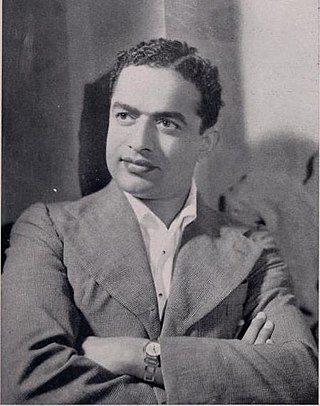
Shantaram Rajaram Vankudre, referred to as V. Shantaram or Shantaram Bapu, was an Indian filmmaker, film producer, and actor known for his work in Hindi and Marathi films. He is most known for films such as Dr. Kotnis Ki Amar Kahani (1946), Amar Bhoopali (1951), Jhanak Jhanak Payal Baaje (1955), Do Aankhen Barah Haath (1957), Navrang (1959), Duniya Na Mane (1937), Pinjara (1972), Chani, Iye Marathiche Nagari and Zunj.
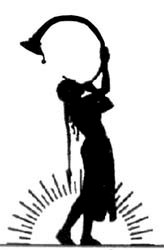
Prabhat Film Company was an Indian film production company and film studios founded in 1929 by the noted film director V.Shantaram and his friends.

Ayodhyecha Raja, literally "The King of Ayodhya", was the first Marathi talkie, released in 1932, directed by Shantaram Rajaram Vankudre. It is based on the puranic story of Raja Harishchandra of Ayodhya and his test by sage Vishwamitra, as recounted in Valmiki's epic, Ramayana.
Maharashtra Film Company was an Indian film production company, established by Baburao Painter in Kolhapur. Established in 1918, it was a silent film studio, which was a pioneer in Maharashtra and Marathi cinema, under the patronage of the Shahu Maharaj, the Maharaja of Kolhapur. It released the first significant historical, Sairandhari, released in Pune 7 February 1920. In the coming decade the only other major company was Dada Saheb Phalke's Hindustan Film Company. It made numerous films till the advent of talkies in 1931, but started collapsing after V. Shantaram left in 1929, to form Prabhat Film Company, it finally closed down in 1931.
Vishnupant Govind Damle was an Indian production designer, cinematographer, film director and sound engineer for Marathi films. His 1937 film Sant Tukaram was the first Indian film to be screened at an international film festival. It won a "Special Recommendation" at the 5th Venice International Film Festival.
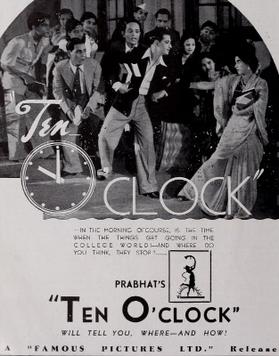
Das Baje, also called 10 O'Clock, is an Indian film. It was released in 1942. This was a debut direction for Raja Nene, a protege of V. Shantaram, and produced under Shantaram's Prabhat Film Company banner. The film was a bilingual, made in Hindi, and in the Marathi language as Daha Wajta. The music direction was by Keshavrao Bhole. The story was written by Kashyap and Pawar, with dialogues in Hindi by Ashant. The photography was by E. Mohammed. It starred Paresh Bannerji, Urmila and Vasant Thengdi in the lead roles, with Baby Shakuntala and Manajirao forming the supporting cast.
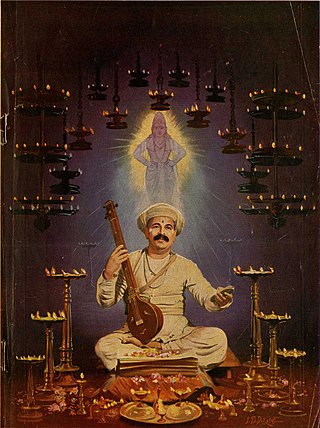
Sant Tukaram, also known as Saint Tukaram, is a 1936 Marathi film, produced by Prabhat Film Company and based on the life of Tukaram (1608–50), a prominent Varkari saint and spiritual poet of the Bhakti movement in India. The film was directed by Vishnupant Govind Damle and Sheikh Fattelal and featured Vishnupant Pagnis in the lead role of the saint.

Amrit Manthan is a 1934 Indian costume-drama film directed by V. Shantaram for his Prabhat Film Company. The film was produced simultaneously in Hindi and Marathi. The film starred Chandra Mohan, Nalini Tarkhad, Shanta Apte, G. R. Mane, Varde and Kelkar. The film was based on Narayan Hari Apte's novel Bhagyashree. The Hindi translation was done by Veer Mohammed Puri, who also wrote the lyrics for the film.
Netaji Palkar is a 1927 Indian biopic historical silent film directed by V. Shantaram. Kaishavrao Dhaiber who was an apprentice with Damle, co-directed the film. He was to become the chief cinematographer for Shantaram in his later films. Made under the Maharashtra Film Company, Kolhapur, it was the first film directed by Shantaram. The director of photography was S. Fattelal and the cast included Ansuya, Balasaheb Yadav, Ganpat Bakre and Zunzarrao Pawar.
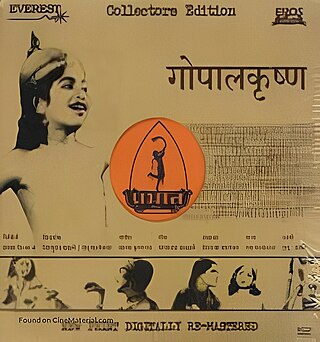
Gopal Krishna is an Indian religious silent film made in 1929. It was directed by V. Shantaram for his newly formed Prabhat Film Company. The film was a "solo debut" for Shantaram, after co-directing Netaji Palkar (1927) with K. Dhaiber for the Maharashtra Film Company. The story was written by Shivram Vashikar and the cast composed of Suresh, Kamaladevi, Anant Apte, Sakribai and G.R. Mane.

Chandrasena is a 1935 Hindi/Marathi mythology drama film directed by V. Shantaram for his Prabhat Film Company. The film was the first Indian trilingual film to be made simultaneously in Hindi, Marathi. The cinematographer was K. Dhiaber and the story and dialogue were by Shivram Vashikar. The music direction was by Keshavrao Bhole, with lyrics written by K. Narayan Kale. The cast included Nalini Tarkhud, Sureshbabu Mane, Kelkar, Rajani, Shantabai and Azurie.
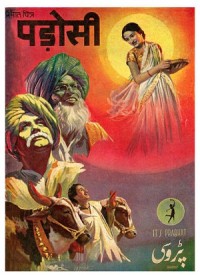
Shejari is also known as Padosi in Hindi version as. Padosi is a 1941 Indian social drama film directed by V. Shantaram. It was produced by Prabhat Film Company and the bilingual film in Marathi and Hindi was the last film Shantaram made for Prabhat before venturing to form his Rajkamal Kalamandir. The film is cited as one of the three social classics Shantaram made at Prabhat. The other two were Duniya Na Mane (1937) and Aadmi (1939). The story and dialogue were by Vishram Bedekar in the Marathi version, while the dialogues in the Hindi version were by Pandit Sudarshan, who also wrote the lyrics. The music director was Master Krishnarao. The famous character artist Radhakrishan made his acting debut in the film as a villain. The film starred Mazhar Khan, Gajanan Jagirdar, Anees Khatoon, Radha Kishan, Lajwanti, Sumitra, Gopal and Balak Ram.

Udaykal is a 1930 historical silent film co-directed by V. Shantaram and Keshavrao Dhaiber. It was produced by Prabhat Film Company. The story was written by Baburao Pendharkar. The cinematographers were S. Fattelal and V. G. Damle. The film starred V. Shantaram, Baburao Pendharkar, Kamla Devi, G. R. Mane, Ibrahim and Dhaiber.

Sinhagad is a 1933 Marathi historical fact film directed by V. Shantaram. The production company was Prabhat Film Company. The story was based on Hari Narayan Apte's literary classic novel "Gad Ala Pan Sinha Gela". Apte was a famous Marathi novelist of the early twentieth century. The story's screenplay and dialogue were written by Narayan Hari Apte. The cinematographers were V. Avadhoot and Keshavrao Dhaiber. The cast included Master Vinayak, Baburao Pendharkar, Keshavrao Dhaiber, Leela Chandragiri, Shinde, Prabhavati, Budasaheb and Shankarrao Bhosle.
Rani Saheba also called Bazarbattu is a 1930 Indian silent film. It is cited as the first children's film made in India. The film was co-directed by V. Shantaram and Keshavrao Dhaiber. The cinematographers were S. Fattelal and Vishnupant Govind Damle and the cast included Keshavrao Dhaiber, Baburao Pendharkar, V. Shantaram and Anant Apte.

Manoos, also called Life's for Living, is a 1939 Indian Marathi social melodrama film directed by V. Shantaram. The movie was simultaneously made in Hindi as Aadmi. The film was based on a short story called "The Police Constable". The story was by A. Bhaskarrao, with screenplay and dialogue by Anant Kanekar. The cinematographer was V. Avadhoot and the music was composed by Master Krishna Rao, with lyrics by Kanekar. The cast included Shahu Modak, Shanta Hublikar, Sundara Bai, Ram Marathe, Narmada, Ganpatrao and Raja Paranjpe.
Chandrasena is a 1931 Indian silent film directed by V. Shantaram and Keshavrao Dhaiber. The director of photography was Keshavrao Dhaiber. Produced under the banner of Prabhat Film Company, the film brought the company into the "frontline" of film makers. The cast included Lila, "alias" Lilavati Pendharkar, who was making her debut with this film, with Kamla, Gulabbai and G. R. Mane.
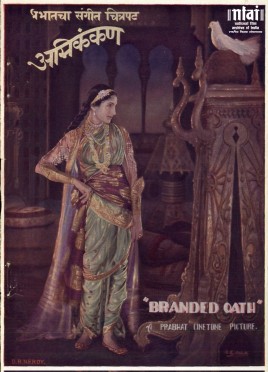
Agnikankan: Branded Oath also called The Branded Oath, is a 1932 Marathi adventure film directed by V. Shantaram. The film was a Prabhat Film Company production and was a bilingual, called Jalti Nishani in Hindi. The cinematography was done by Keshavrao Dhaiber and Art direction by S. Fatehlal. The sound direction was by Vishnupant Govind Damle and the music and lyrics were by Govindrao Tembe. Dialogues for the movie are written by Govindrao Tembe. The character artist Gajanan Jagirdar began his career in films by acting the role of a seventy-five-year-old man at the age of twenty-five. The cast included Shankarrao Bhosle, Kamala Devi, Master Vinayak, Baburao Pendharkar, Nimbalkar and Jagirdar.

Sairandhari (सैरंध्री) a 1933 Indian film based on an episode from the Mahabharata and directed by V. Shantaram. The film was a bilingual made as Sairandhari in both Marathi and Hindi. Produced by Prabhat Film Company, it has been cited as one of the 21 "most wanted missing Indian treasures" by P K. Nair, the National Film Archive of India founder. The music composer was Govindrao Tembe. The cast included Master Vinayak, Leela, Prabhavati, Shakuntala, G.R. Mane, Nimbalkar and Shankarrao Bhosle.
References
- ↑ Sanjit Narwekar; Raghuvir Kul; D. B. Samant; Maharashtra Film, Stage & Cultural Development Corporation (1995). Marathi Cinema: in retrospect. Maharashtra Film, Stage & Cultural Development Corp. Retrieved 18 February 2015.
- ↑ "Khooni Khanjar (1930)". gomolo.com. Retrieved 18 February 2015.
- ↑ "Khooni Khanjar". chiloka.com. Retrieved 18 February 2015.
- ↑ "Khooni Khanjar". citwf.com. Alan Goble. Retrieved 18 February 2015.
- ↑ B D Garga (1 December 2005). Art Of Cinema. Penguin Books Limited. pp. 66–. ISBN 978-81-8475-431-5 . Retrieved 18 February 2015.